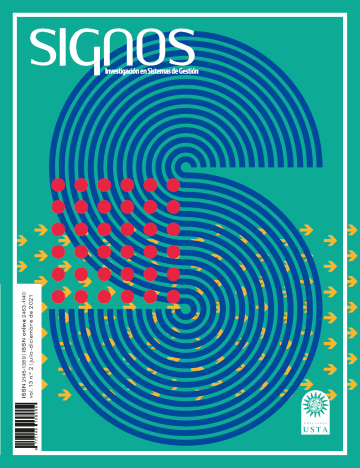Sistemas de gestión normalizados y su contribución al control de los efectos organizacionales generados por la COVID-19
Abstract (en)
Los sistemas de gestión normalizados se han creado como herramientas para aportar al desarrollo de las organizaciones. En este sentido, la organización internacional de estandarización ha creado normas técnicas en diferentes temáticas, disciplinas y sectores económicos. Actualmente, ante la pandemia generada por el SARS CoV-2, los países y las organizaciones se ven en la necesidad de generar alternativas para mitigar y controlar la enfermedad COVID-19, la cual, sin lugar a duda, ha generado una gran afectación en la salud de las personas y en la sostenibilidad de los negocios.
References
BSI. (2018). Occupational health and safety management systems – General guidelines for the application of ISO 45001 Part 3: Guidance on incident investigation. BSI.
Decreto 1072 del 2015 (26 de mayo), Por medio del cual se expide el Decreto Único Reglamentario del Sector Trabajo. Diario oficial 49523. http://www.mintrabajo.gov.co/normatividad/decreto-unico-reglamentario
Departamento de Comunicación Global de las Naciones Unidas. (2021). World Economic Situation and Prospects 2021. https://www.un.org/development/desa/dpad/wp-content/uploads/sites/45/WESP_2021_Global_Press_Release_S.pdf
Icontec. (2015a). NTC ISO 9001:2015. Requisitos de gestión de la calidad. Requisitos. Icontec.
Icontec. (2015b). NTC ISO 14001:2015. Icontec.
Icontec. (2018). NTC 58001 Sistema de gestión de la innovación. Requisitos. Icontec.
Icontec. (2018). NTC ISO 45001:2018. Sistemas de gestión de la seguridad y salud en el trabajo—Requisitos con orientación para su uso. ICONTEC.
Icontec. (2020). GTC-ISO 22313. Seguridad y resiliencia. Sistemas de continuidad de negocio. Orientación sobre el uso de la NTC ISO 22301 (Icontec).
Icontec. (2021). Sello de Certificación. Operaciones Bioseguras. https://www.icontec.org/sello-de-certificacion/
International Organization for Standardization. (2019). ISO 22301. Security and resilience. Business continuity management systems. Requirements. International Organization for Standardization.
ISO. (2017). IWA 26:2017. Using ISO 26000:2010 in management systems.
ISO. (2018). ISO 31000. Risk management—Guidelines. ISO.
ISO. (2019). ISO 26000:2019. Guidance on social responsibility. ISO.
ISO. (2020). ISO/PAS 45005:2020. Occupational health and safety management — General guidelines for safe working during the COVID-19 pandemic. https://www.iso.org/standard/64286.html
Resolución 0312 del 2019 (13 de febrero), Por la cual se definen los Estándares Mínimos del Sistema de Gestión de la Seguridad y Salud en el Trabajo SG-SST. Diario oficial 50872. https://id.presidencia.gov.co/Documents/190219_Resolucion0312EstandaresMinimosSeguridadSalud.pdf
Resolución 1401 del 2007 (24 de mayo), Por la cual se reglamenta la investigación de incidentes y accidentes de trabajo. Diario oficial 46.638. https://www.minsalud.gov.co/sites/rid/Lists/BibliotecaDigital/RIDE/DE/DIJ/resolucion-1401-2007.pdf
Organización Internacional del Trabajo. (2001). Directrices relativas a los sistemas de gestión de la seguridad y la salud en el trabajo, ILO-OSH 2001. https://www.ilo.org/safework/info/standards-and-instruments/WCMS_112582/lang--es/index.htm
Zhao, W., & Jiang, Z. (2020). Research on Occupational Health and Safety of Medical Staff Based on ISO 45001. American Journal of Biochemistry and Biotechnology, 16(3), 288-298. https://doi.org/10.3844/ajbbsp.2020.288.29
Visitas
Downloads
How to Cite
License

This work is licensed under a Creative Commons Attribution-NonCommercial-ShareAlike 4.0 International License.
The authors keep the rights to the articles and therefore they are free to share, copy, distribute, execute and publicly communicate the work under the following conditions:
To recognize the credits of the work in the way specified by the author or licensor (but not in a way that suggests that they have their support or that they support the use of their work).
SIGNOS is licensed under Creative Commons Atribución-NoComercial-CompartirIgual 4.0 Internacional (CC BY-NC-SA 4.0)

The Universidad Santo Tomás preserves the proprietary rights (copyright) of the published works, and favors and allows the reuse of the same under the aforementioned license.






